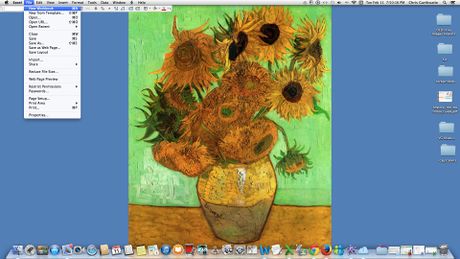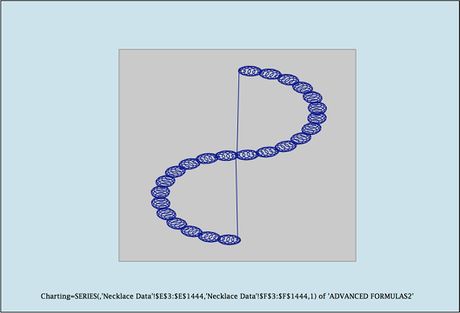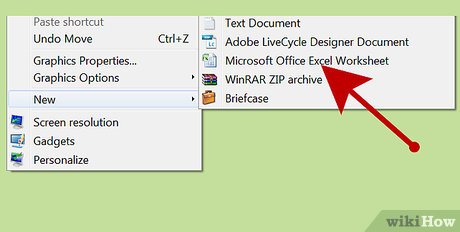How to Create an S Curve Pattern in Microsoft Excel
Part 1 of 3:
The Tutorial
-


 This workbook builds on the progress achieved in the article Create a Necklace Pattern in Microsoft Excel and it would be helpful to simply copy from that file and modify it. However, a basic understanding of design principles, such as what happens to a curve when one adds to it versus when one multiplies to it, would be helpful -- so starting fresh might be a good idea too. Here, a basic adjustment is added to the Garthwaite Curve. That adjustment is a little complicated but the user is encouraged to substitute their own values and observe the effects of so doing.
This workbook builds on the progress achieved in the article Create a Necklace Pattern in Microsoft Excel and it would be helpful to simply copy from that file and modify it. However, a basic understanding of design principles, such as what happens to a curve when one adds to it versus when one multiplies to it, would be helpful -- so starting fresh might be a good idea too. Here, a basic adjustment is added to the Garthwaite Curve. That adjustment is a little complicated but the user is encouraged to substitute their own values and observe the effects of so doing. -


Set Preferences. Open Preferences in the Excel menu. Recommended Settings: Set General to R1C1 Off and Show the 10 Most Recent Documents; Edit - set all the Top options to checked except Automatically Convert Date System. Display number of decimal places = blank (for integers preferred), Preserve display of dates and set 30 for 21st century cutoff; View - show Formula Bar and Status Bar, hover for comments and all of Objects, Show grid lines and all boxes below that auto or checked; Chart - show chart names and data markers on hover. Leave rest unchecked for now; Calculation -- Automatically and calculate before save, max change .000,000,000,000,01 w/o commas if you do goal-seeking a lot and save external link values and use 1904 system; Error checking - check all; Save - save preview picture with new files and Save Autorecover after 5 minutes; Ribbon -- all checked except Hide group titles and Developer. -

 Create a copy of the Data worksheet from Create a Necklace Pattern in Microsoft Excel and rename variables AdjX to AdjX1 and AdjY to AdjY1 and Insert Name create for their columns and substitute the new variable names into column E and F formulas (which will also change - see below), and see below for changes to columns G and H, or Create the Defined Variables upper section of the Data worksheet as follows:
Create a copy of the Data worksheet from Create a Necklace Pattern in Microsoft Excel and rename variables AdjX to AdjX1 and AdjY to AdjY1 and Insert Name create for their columns and substitute the new variable names into column E and F formulas (which will also change - see below), and see below for changes to columns G and H, or Create the Defined Variables upper section of the Data worksheet as follows:- Enter AROWS into cell A1 and 1439 into cell A2. Insert Name Define Name AROWS to cell $A$2.
- Enter FACTORY into cell C1 and -.25 into cell C2. Insert Name Define Name FACTORY to cell $C$2.
- Enter GM into cell D1 and w/o spaces 0.618 033 988 749 895 into cell D2. Insert Name Define Name GM to cell $D$2.
- Enter Adj1 into cell G1 and 0 into cell G2.
- Enter Adj2 into cell H1 and 0 into cell H2.
- Command-Select cells A2, C2, D2, G2 and H2 and Format Cells Border Black Outline. Select cell range A1:H2 and align horizontal center.
-
 Create the Column Headings section of the Data worksheet.
Create the Column Headings section of the Data worksheet.- Enter Base t into cell A3.
- Enter c into cell B3.
- Enter cos into cell C3.
- Enter sin into cell D3.
- Enter x into cell E3.
- Enter y into cell F3.
- Enter AdjX into cell G3.
- Enter AdjY into cell H3.
- Select A3:H3 and align center and Font underline single underline.
-
 Enter the Column Formulas.
Enter the Column Formulas.- Enter "=ROUND((308100*PI())+(190),0)" w/o quotes into cell A4. Format Cell Number Number Custom "tip" 0 including quotes. Insert Name Define Name tip to cell $A$4.
- Edit Go To cell range A5:A1444 and with A5 active, enter w/o quotes the formula "=((A4+(-tip*2)/(AROWS)))" into A5 and Edit Fill Down.
- Select cell AAB4 and enter -25822 into it. Edit Go To cell range B5:B1444 and with B5 active, enter "=B4" w/o quotes into it and then Edit Fill Down.
- Edit Go To cell range C4:C1444 and with C4 active, enter w/o quotes the formula into it, "=COS((ROW()-4)*PI()/180*FACTORY)". Factory Note: .25*1440 = 360, one full circle/cycle.
- Edit Go To cell range D4:D1444 and with D4 active, enter w/o quotes the formula into it, "=SIN(ROW()-4)*PI()/180*FACTORY)".
- NEW: Edit Go To cell range E4:E1444 and with E4 active, enter w/o quotes the formula into it, "=((SIN(A4/(B4*2))*GM*COS(A4)*GM*(COS(A4/(B4*2)))*GM)+C4)+AdjX1" and Edit Fill Down. This is not the previous double whammy.
- NEW: Edit Go To cell range F4:F1444 and with F4 active, enter w/o quotes the formula into it, "=((SIN(A4/(B4*2))*GM*SIN(A4)*GM*(COS(A4/(B4*2)))*GM)+D4)+AdjY1" and Edit Fill Down,
- NEW: Edit Go To cell range G4:G1444 and enter "=SIN((C4+D4)*PI()/180)*IF(C4<0,1,-1)" as entered to G4, the do Edit Fill Down.
- NEW: Edit Go To cell range H4:H1444 and enter "=COS((C4+D4)*PI()/180)*IF(C4<0,1,-1)" as entered to H4, the do Edit Fill Down.
- In the above two formulas, reverse the final two 1 and negative 1's to reverse the direction of the S-curve. Make a copy of each formula and copy it it to G and H 1446 and 1447 with a note in I1446 and I1447 "Reverse S Direction".
Part 2 of 3:
Explanatory Charts, Diagrams, Photos
- (dependent upon the tutorial data above)
-
 Create the Chart.
Create the Chart.- Edit Go To cell range E4:F1444 and, using either the Chart Wizard or the Ribbon, select Chart, All/Other, Scatter - Smooth Line Scatter. If not using Chart Wizard, a small chart should appear atop the data. Copy or Cut and Paste the Chart to the Chart worksheet you create anew now, into cell A1, and expand the chart by hovering over the lower right corner until the cursor becomes the double-headed arrow allowing one to pull down and to the right the chart, expanding it. Using Chart Layout, Select Data Series 1 and Format Selection Line Weight 1. Then select the Plot Area and format Fill grey. Then format Chart Area sky blue fill. Insert Picture WordArt whatever text you feel is appropriate, and format it by clicking on the Home Ribbon tab and using the edit tools.
- To get rid of the annoying vertical line, Edit Clear Contents from E1084:F1086 and E364:F367 (this works at least when the S is in forward-facing position).
- Hold down the shift key and copy picture to the Saves worksheet to be created anew, along with the formulas and pasted values from the top rows of the Data worksheet.
-

It would be a good idea to Insert New Comment on the original values and formulas of the Data worksheet so that renormalization is a few steps away. Done!
Part 3 of 3:
Helpful Guidance
- Make use of helper articles when proceeding through this tutorial:
- See the article How to Create a Spirallic Spin Particle Path or Necklace Form or Spherical Border for a list of articles related to Excel, Geometric and/or Trigonometric Art, Charting/Diagramming and Algebraic Formulation.
- For more art charts and graphs, you might also want to click on Category:Microsoft Excel Imagery, Category:Mathematics, Category:Spreadsheets or Category:Graphics to view many Excel worksheets and charts where Trigonometry, Geometry and Calculus have been turned into Art, or simply click on the category as appears in the upper right white portion of this page, or at the bottom left of the page.
4 ★ | 3 Vote
You should read it
- Inspirational quotes from the world's most famous women
- How to Acquire Bézier Curves Using Excel
- How to Round in Excel
- Turn off turn on the character repeat function in Excel
- How to Create a Necklace Pattern in Microsoft Excel
- 25 inspirational quotes by Tony Robbins
- When you encounter failure, remember these sayings
- How to Create a Different Necklace Pattern in Microsoft Excel
May be interested
- How to Create a Uniform Spiral Pattern in Microsoft Excel
 in this article, you'll learn to make the 'uniform spiral' pattern and image below, and the dozens of variations the file permits therefrom. become familiar with the image to be created: === previous lessons learned ===
in this article, you'll learn to make the 'uniform spiral' pattern and image below, and the dozens of variations the file permits therefrom. become familiar with the image to be created: === previous lessons learned === - How to Create a Line of Spheres Pattern in Microsoft Excel
 you'll learn to make the 'line of spheres' pattern and image below, and the dozens of variations the file permits therefrom. become familiar with the basic image to be created:
you'll learn to make the 'line of spheres' pattern and image below, and the dozens of variations the file permits therefrom. become familiar with the basic image to be created: - How to Create a Squiggly Frame Pattern in Microsoft Excel
 in this article, you'll learn to make the 'squiggly frame' pattern and image below, and the dozens of variations the file permits therefrom. become familiar with the basic image to be created:
in this article, you'll learn to make the 'squiggly frame' pattern and image below, and the dozens of variations the file permits therefrom. become familiar with the basic image to be created: - How to Create a Skewed Spheroids Pattern in Microsoft Excel
 in this article, you'll learn to make the 'skewed spheroids' pattern like the image below, and the dozens of variations the file permits therefrom. this article relies on the previous accomplishment of the five articles preceding it:
in this article, you'll learn to make the 'skewed spheroids' pattern like the image below, and the dozens of variations the file permits therefrom. this article relies on the previous accomplishment of the five articles preceding it: - How to Create a Lemniscate Spheroid Curve
 herein the lemniscate, or infinity curve, is taught -- in two different approaches, one normal and one slanted. the normal one will have the garthwaite curve's spheroids developed into it, while the slanted one will remain as a project for...
herein the lemniscate, or infinity curve, is taught -- in two different approaches, one normal and one slanted. the normal one will have the garthwaite curve's spheroids developed into it, while the slanted one will remain as a project for... - How to create a pie chart in Microsoft Excel
 pie charts are a great tool for visualizing information. it allows users to see the partial relationship with the entire data.
pie charts are a great tool for visualizing information. it allows users to see the partial relationship with the entire data. - How to Create a Chart in Excel
 in this article, tipsmake will show you how to create visual data visualizations in microsoft excel using pie charts. open the microsoft excel program.
in this article, tipsmake will show you how to create visual data visualizations in microsoft excel using pie charts. open the microsoft excel program. - How to Reset Lock Pattern on Android Tablet
 today's tipsmake will show you how to create or change the home screen unlock pattern of your android tablet. you can also access your tablet if you forget your unlock pattern. if you use a version released after android 4.4 (kitkat), the only way to restore the unlock pattern (if you forget it) is to erase all data on the tablet and reinstall it from scratch.
today's tipsmake will show you how to create or change the home screen unlock pattern of your android tablet. you can also access your tablet if you forget your unlock pattern. if you use a version released after android 4.4 (kitkat), the only way to restore the unlock pattern (if you forget it) is to erase all data on the tablet and reinstall it from scratch. - LOGEST - The function returns an array of data that describes an exponential curve that fits the data given in Excel
 logest: the function returns the data array that describes the exponential curve that fits the given data. - the equation of the curve is: y = b * m ^ x or y = (b * (m1 ^ x1) * (m2 ^ x2) * _) syntax: logest (known_ys, [known_xs], [const], [ stats])
logest: the function returns the data array that describes the exponential curve that fits the given data. - the equation of the curve is: y = b * m ^ x or y = (b * (m1 ^ x1) * (m2 ^ x2) * _) syntax: logest (known_ys, [known_xs], [const], [ stats]) - Complete tutorial of Excel 2016 (Part 3): How to create and open existing spreadsheets
 today, we continue to share with you how to create and open spreadsheets available in excel 2016.
today, we continue to share with you how to create and open spreadsheets available in excel 2016.














 How to Color Inside the Lines in FireAlpaca
How to Color Inside the Lines in FireAlpaca How to Use Weavesilk
How to Use Weavesilk How to Make a Monogram
How to Make a Monogram How to Acquire the Black Mosaic Tile Image via Excel
How to Acquire the Black Mosaic Tile Image via Excel How to Use Waifu2x
How to Use Waifu2x